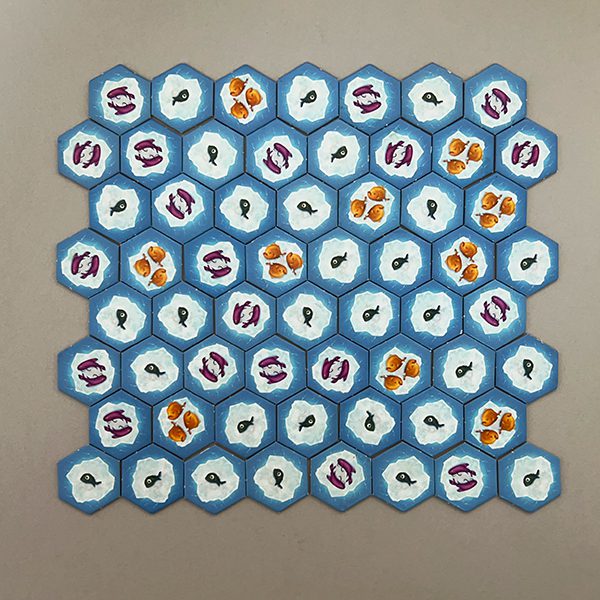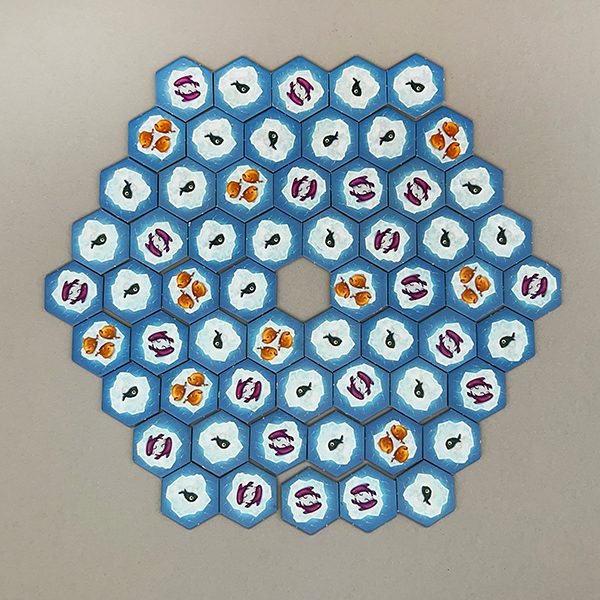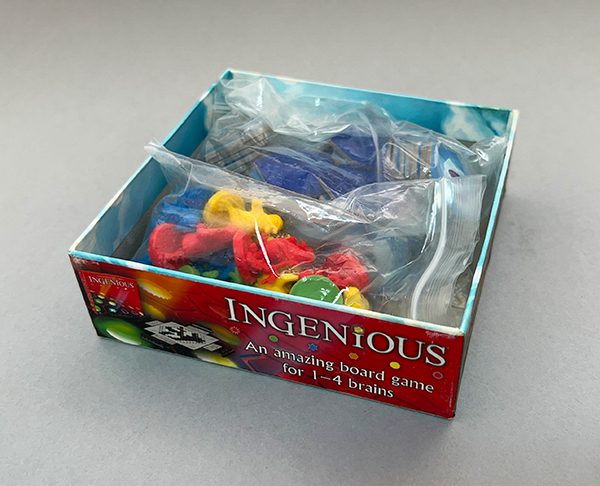One of the common traits amongst most Abstract Strategy games is that they have no theme, no story, no background. It’s just a board, a set of pieces, and a set of simple rules.
Sometimes, though, that abstract nature has the thinnest of veneers applied to it. Consider Chess, a game with Kings, Queens, Knights, and Bishops. Those names give the game a regal feel, but the pieces could just as easily be named Rectangle, Octagon, and Triangle. None of the timeless feel of the game would be lost.

Allow me to give you another example of the slightest of themes: colorful penguins and fish. This could just as easily have been squirrels and nuts, butterflies and flowers, or cubes and rings.
But then they would have had to find another name for Hey, That’s My Fish!
Don’t let these emotive penguins fool you.

At its root, Hey, That’s My Fish! is purely an abstract.
Let’s get this to the table, shall we?
Setup & Playing the Game
You’ll start the game by building the board. Turn the 60 hex tiles ice-floe-with-fish side up and arrange them in an agreed upon, symmetrical pattern.

(Consult The Google for variations—my personal one is a large hex with the center hex/ice flow missing.

Ice flows will have from one to three fish on them. Each fish equals one point for the player whose penguin lands on it. A random distribution of all tiles is encouraged, so swap out tiles as necessary to keep any clusters of two or three fish from forming.
Players then start the game by placing their colored penguins on ice floes containing only one fish until all penguins are on the board.
Then, in order, each player moves a single penguin of their color from one hex/ice floe to another in an uninterrupted straight line. They then carefully take the hex/ice flow they moved from and remove it from the board, leaving a gap that no penguin can cross over. The removed hex/ice floe becomes part of that player’s hoard of fish and will count towards their final fish count at the end of the game.
As the game progresses, the available landing points diminish as more and more ice floes disappear from the board. If you’re ever cut off from the main board, you’ll gain the fish on the island of ice floes, but that penguin is out of the game.

Whoever has the most fish at the end wins the game.
Thoughts
Initially, I thought Hey, That’s My Fish! was a lightweight filler of a game. It was short, amusing, and fun to try to strand other players’ penguins on less-productive stretches of fish and ice.
Then I started playing it online with a friend. The online site we use only allows for two-player games and, more importantly, allows for asynchronous playing. When my friend makes a move, I get notified via email that it is my turn.
This changed Hey, That’s My Fish! from a simple, lighthearted game, into a strategic battle that I ponder over as much as I’ve ever studied a Chess board.
Much like ZERTZ, the board also changes with every move. While this board doesn’t eat away at itself from the outside, the new, inner empty spaces quickly serve as blockades to limit how far a penguin can travel. Done well, these gaps also keep an opponent’s penguins from reaching some of the more fish-y floes.
While it’s easy to focus on the three-fish ice floes—the highest fish count there is on any of the tiles—there is a possibility that doing so might cause a greedy penguin to be cut off from the larger board. You’ll not only have to do a risk assessment on that penguin’s earning potential, but you’ll also need to reconsider all your penguins when it’s your turn again because your opponent is trying to cut you off from parts of the board as well.
With the random placement of the hex tiles/ice floes at the start of each game, there is no single strategy to winning. Add to that the aforementioned number of possible starting shapes, and you have a game that’s light enough to entertain children while becoming as think-y as you’d like it to be.

Hey, That’s My Fish! is a surprisingly complex game when played with any number and deserves more attention from serious gamers. Don’t let the vague, cutesy theme distract you—this is a serious abstract worthy of your consideration.











Great review!
When I was first introduced to this game, my friend Steve described it as the most ruthless game he had ever played. And with the people I have played this game with, I would tend to agree.
Moves in this game can be brutal!
Like you said, the cutesy nature of the pieces and artwork is a disguise for a game that can be an amazing brain-burner.
It really is a very tactical game. That it comes disguised as a cutesy penguin game makes it all the more devious.
BGG has a number of different starting shapes for the ice floes/fish, all of which will change the game. One suggestion I remember reading was to take one of the 3 fish floes and put a mark on the back. That indicates there was a shark waiting under the floe that eats the penguin who moves off of it, thereby eliminating it from the game. I like that idea. It adds some tension when going after those 3 fish floes.